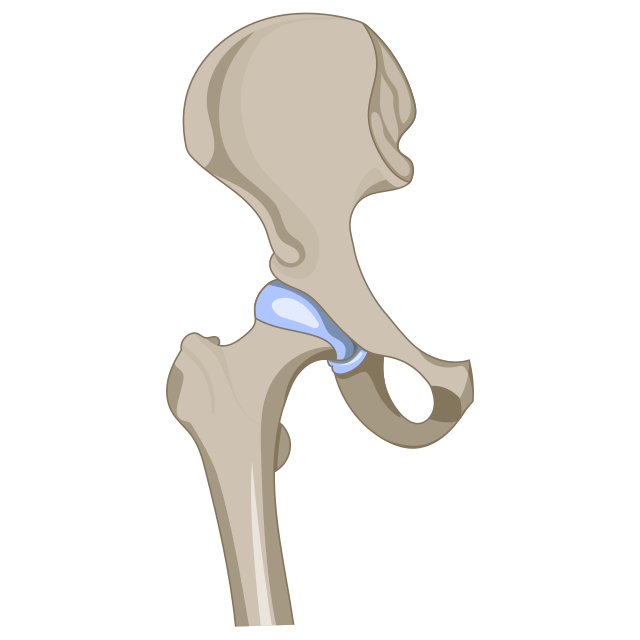Functional Anatomy of the Hip - Neural and Vascular
Original Editor - Rishika Babburu
Top Contributors - Rishika Babburu, Ewa Jaraczewska and Kim Jackson
Introduction[edit | edit source]
The hip joint is a synovial joint with articulation between the femoral head and the acetabulum of the pelvis. The rounded femoral head sits within the cup-shaped acetabulum of pelvis.
Nerve Supply[edit | edit source]
Hilton's law states “The same trunks of nerves, whose branches supply the groups of muscles moving a joint, furnish also a distribution of nerves to the skin over the insertions of the same muscles; and – what at this moment more especially merits our attention – the interior of the joint receives its nerves from the same source.” [1]A joint tends to be innervated by a branch of a motor nerve which also supplies a muscle extending and acting across the joint,another branch of the nerve often supplies the overlying skin.[2]
- The obturator nerve is considered the primary source of innervation to the hip.
- Branches of the femoral and sciatic nerves contribute to its sensory innervation.[3]
- The hip joint receives multiple innervations primarily involving the hip capsule.
- The posterior articular nerve, a branch of the nerve to the quadratus femoris provides the most extensive nerve supply to the hip joint, including the posterior and inferior regions of the capsule and the ischiofemoral ligament.
- Superiorly, the hip capsule is innervated by the superior gluteal nerve.
- Anterior innervation of the capsule is provided by direct branches of the femoral nerve.
- The anteromedial and anteroinferior regions are supplied by the medial articular nerve, which arises from the anterior division of the obturator nerve .
- The ligamentum teres is innervated by the posterior branch of the obturator nerve .[4] [5]
- Acetabular labrum consists of sensory nerve end organs and ramified free nerve endings, suggest that the labrum may provide nociceptive and proprioceptive feedback to and from the hip joint [6]
Arterial Supply[edit | edit source]
Arterial supply of hip joint is by the cruciate and trochanteric anastomoses supply . A branch from the posterior branch of the obturator artery may also be present in the ligamentum teres.
Cruciate anastomosis
- Transverse branch of medial circumflex femoral artery
- Transverse branch of lateral circumflex femoral artery
- Ascending branch of first perforator artery from profunda femoris artery
- Descending branch of inferior gluteal artery
- Obturator artery
Trochanteric anastomosis
- Descending branch of superior gluteal artery
- Ascending branch of medial circumflex femoral artery
- Ascending branch of lateral circumflex femoral artery
- Inferior gluteal artery[7][8]
Clinical Importance[edit | edit source]
Avascular necrosis of the hip is a condition characterized by the death of the femoral head due to disruption of its vascular supply, mainly by Medial Femoral Circumflex Artery. It leads to insidious onset of hip pain, usually with movement, and can be the result of a variety of factors. Some of the most common causes can be remembered by the mnemonic “ASEPTIC”:
- Alcohol/AIDS
- Steroids, sickle cell disease, SLE
- Erlenmeyer flask (Gaucher disease)
- Pancreatitis
- Trauma
- Idiopathic (Legg-Calve-Perthes disease), infection, iatrogenic
- Caisson disease[9]
References[edit | edit source]
- ↑ John Hilton
- ↑ Hilton's law
- ↑ Hip Anatomy
- ↑ Robbins CE (1998) Anatomy and biomechanics, In: The Hip Handbook edited by Fagerson TL (Eds.); Boston, MA: Butterworth-Heinemann, p. 1-37.
- ↑ Harty M (1984) The anatomy of the hip joint. In: Surgery of the Hip Joint, (2nd edn); edited by Tronzo R, Springer-Verlag, New York, p. 49-74.
- ↑ The nerve endings of the acetabular labrum Y T Kim , H Azuma
- ↑ Hip Joint: Embryology, Anatomy and Biomechanics Volume 12 - Issue 3 Ahmed Zaghloul1* and Elalfy M Mohamed2
- ↑ Hip arthroscopy for lateral cam morphology: how important are the vessels? Austin E Wininger, Lindsay E Barter, Nickolas Boutris, Luis F Pulido, Thomas J Ellis, Shane J Nho, Joshua D Harris
- ↑ Anatomy, Abdomen and Pelvis, Hip Arteries James A. Jordan; Bracken Burns.







